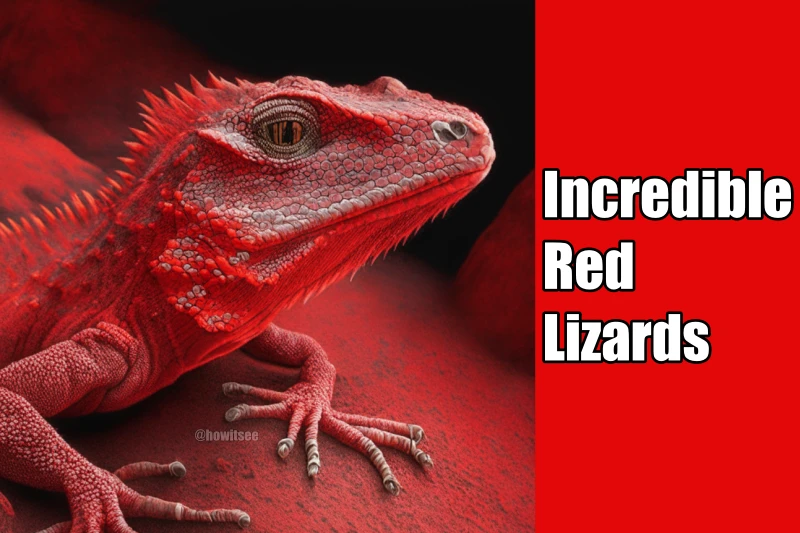In the vast and diverse world of reptiles, few creatures captivate the imagination, quite like the enchanting red lizards. With their vibrant hues reminiscent of flickering flames, these stunning reptilian wonders ignite a sense of awe and wonder.
From the striking red-headed agama to the fiery Red-eyed crocodile skink, these 15 incredible red lizards showcase nature’s mastery of color and evolution. Join us on a journey as we explore the kaleidoscope of nature’s fiery beauty and discover the mesmerizing world of these crimson-hued reptilian marvels.
15 Incredible Red Lizards
1. Red Tegu
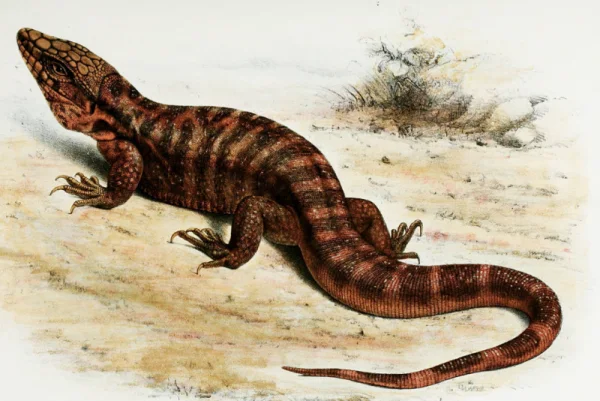
| Scientific Name | Salvator rufescens |
| Length | 90-140 cm |
| Location | Western Argentina, Bolivia, and Paraguay |
| Diet | fruits, vegetables, insects, rodents, birds, and fish |
Let’s begin the list of red lizards with Red Tegu. These lizards can grow up to 140 cm with a weight of 50 pounds. They are muscular with a wide skull, short neck, and forked tongue.
They attain their pinkish-red color as they mature. These lizards are diurnal reptiles means they feed during the daytime. They are extremely intelligent and docile creatures.
2. Red Ackie Monitor
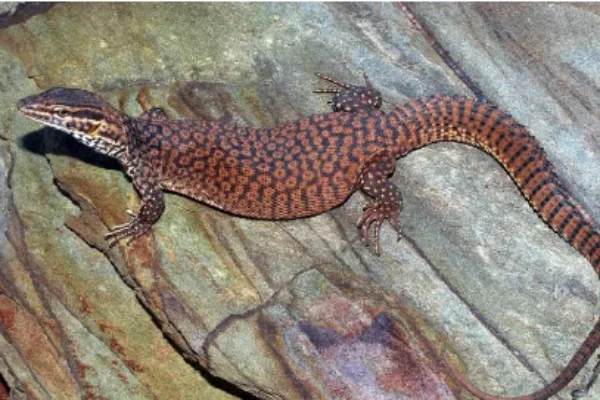
| Scientific Name | Varanus acanthurus |
| Length | 63-72 cm |
| Location | the arid regions of northwest Australia, and parts of Queensland |
| Diet | mice, crickets, hissing cockroaches, mealworms, snails, eggs, and shrimp |
Red Ackie Monitors are one of the most loved pet lizards because they are relatively easy to care for. They are medium-sized beautiful lizards that can grow up to 72 cm weighing up to 400 g.
Their scales are smooth and shiny, and they are typically colored a dark brown or black with reddish-orange spots. Many people call them multi-colored lizards with red spots. They have a life span of 15 to 20 years.
3. Spider-Man Agama
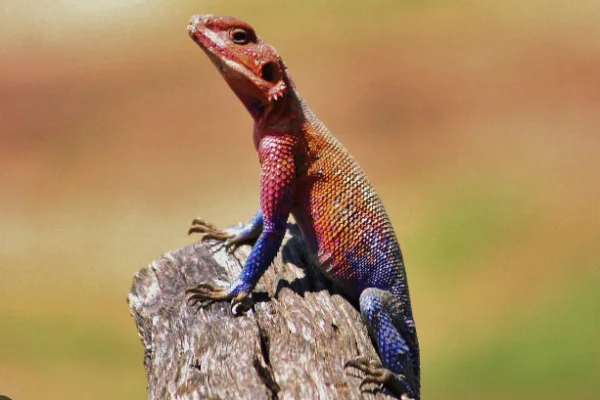
| Scientific Name | Agama mwanzae |
| Length | 15-22 cm |
| Location | Tanzania, Rwanda, and Kenya |
| Diet | crickets mealworms and roaches |
Spider-Man Agamas or Mwanza flat-headed rock agamas are small colorful lizards with a slender build, short legs, and a long tail. Their scales are smooth and shiny, and they are typically colored a bright blue with red or violet markings on the head, neck, and shoulders.
The pinkish-red dominates all the other colors from the head to the upper half body.
Spider-Man Agamas are native to Africa and are found in a variety of habitats, including savannas, grasslands, and rocky outcrops. Like Red Ackie Monitors, these lizards are also popular as pets due to their unique coloration and are easy to care for.
4. Fire Skink

| Scientific Name | Lepidothyris fernandi |
| Length | up to 37 cm |
| Location | tropical rainforests of western Africa |
| Diet | crickets, mealworms, super worms, roaches, and waxworms |
Fire Skinks are medium-sized lizards that can grow up to 37 cm weighing not more than 100 grams. They have smooth and shiny bright red scales with black and white markings. They are diurnal lizards with a variety of habitats, including forests, savannas, and grasslands.
Fire Skinks are omnivores and eat a variety of insects, fruits, and vegetables. They are relatively easy to care for and make good pets for experienced reptile keepers.
5. Peninsular Rock Agama
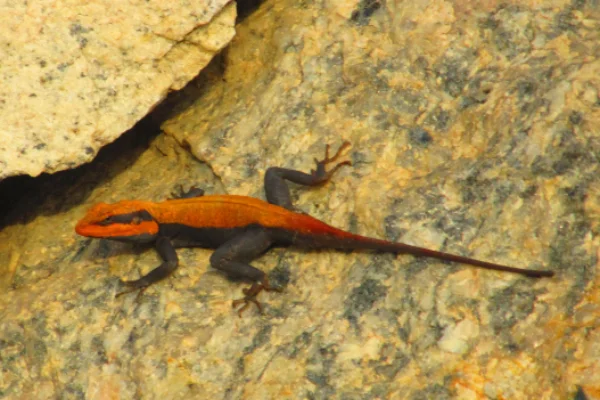
| Scientific Name | Psammophilus dorsalis |
| Length | up to 200 mm |
| Location | Western Ghats, Nilgiris, South Arcot, and Nallamalai Hills |
| Diet | ants, grasshoppers, crickets and beetles, and other insects |
Another red lizard on the list is Peninsular Rock Agama. During the breeding season, the male Peninsular Rock Agamas develops very bright colors, with the upper parts becoming fine vermilion red or yellow to attract females.
They have a black lateral stripe that begins behind the eye and broadens to cover the lower sides as shown in the image. Peninsular Rock Agama primarily feeds on small insects.
6. Frilled Lizard
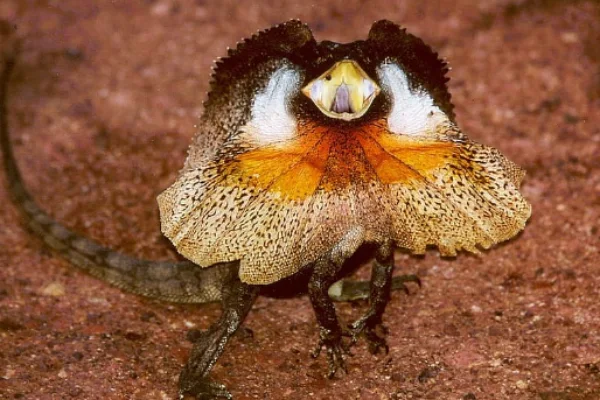
| Scientific Name | Chlamydosaurus kingii |
| Length | up to 90 cm |
| Location | northern Australia, southern New Guinea |
| Diet | spiders, ants, termites, insects, and other small lizards |
Frilled lizards are dark-brown colored lizards with bright red frills that it can extend when threatened. They use their frills to startle predators and make them appear larger than it actually is.
Frilled Lizards are native to Australia and New Guinea and their habitats are forests and woodlands. These lizards are omnivores but primarily feed on spiders, ants, and termites.
7. Halloween Crested Gecko
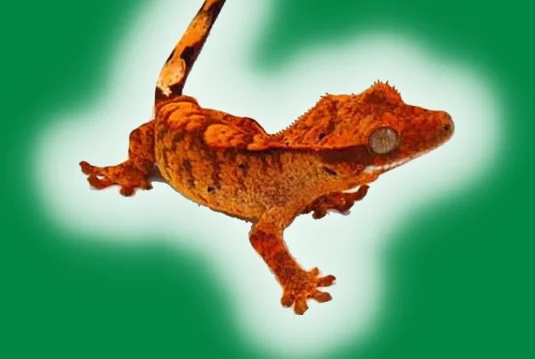
| Scientific Name | Correlophus (Rhacodactylus) ciliatus |
| Length | 10-12 cm |
| Location | Indonesia |
| Diet | powdered food, insects |
Halloween Crested Geckos are small-sized lizards that get their name from their black base color with reddish-orange stripes. These lizards are native to Indonesia and commonly found in tropical forests near rivers and ponds.
They are also popular among pets with an average price of 250 USD to 800 USD depending on their breed. They also have a good lifespan of up to 20 years.
8. Mauritius Ornate Day Gecko
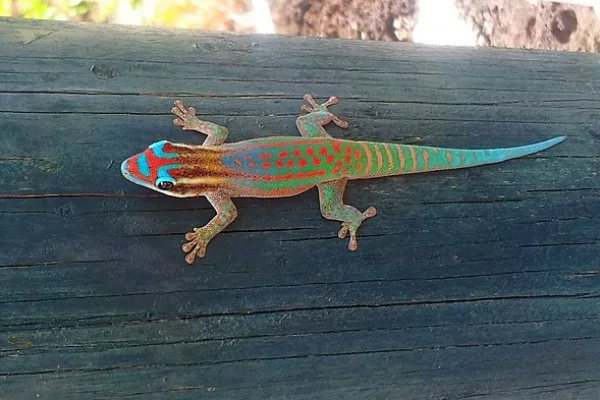
| Scientific Name | Phelsuma ornata ornata |
| Length | about 12 cm |
| Location | tropical forests and coconut plantations on Mauritius, an island in the western half of the Indian Ocean near Madagascar |
| Diet | insects and nectar |
Mauritius Ornate Day Geckos have a primarily green body with vibrant red spots and blue and yellow strips, making them one of the most beautiful lizards. Like most lizards, these lizards are also omnivores that feed on insects and lick pollen, sweet fruits, and nectar.
They can be seen in tropical forests and coconut plantations in Mauritius. Mauritius Ornate Day Geckos are arboreal lizards, meaning that it spends most of its time in trees.
9. Common Butterfly Lizard
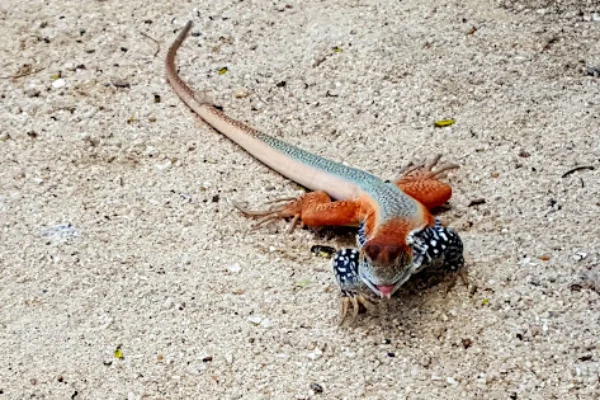
| Scientific Name | Leiolepis belliana |
| Length | approximately 40 cm |
| Location | Cambodia, Indonesia, Malaysia, Myanmar, Thailand, and Vietnam |
| Diet | vegetation, crabs, grasshoppers, beetle larvae, butterflies, and other insects |
The Common Butterfly Lizard is a diurnal lizard with a greenish-grey body, blue legs, and reddish-orange marking on the sides. These lizards have a variety of habitats from agricultural lands to sandy coastal areas.
The male Common Butterfly Lizard develops vibrant red color on its sides to attract females for breeding. These lizards run very fast and feed on beetles, butterflies, grasshoppers, and other insects.
10. Red-tailed Skink
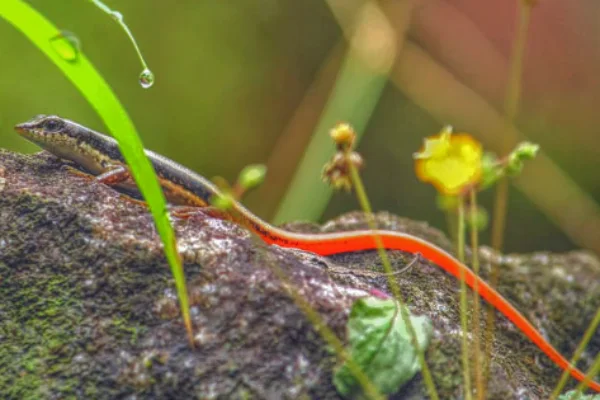
| Scientific Name | Plestiodon gilberti rubricaudatus |
| Length | 10-21 cm |
| Location | Southwestern and Southern Nevada |
| Diet | Insects |
Red-tailed Skinks are small lizards with a maximum length of not more than 21 cm. Adults are greenish-brown in color with a bright red or orange tail.
During the breeding season, the head of males is often red or orange. Juvenile lizards have lighter stripes with blue tails. They are found in a variety of habitats, including forests, grasslands, and deserts.
11. Saharan Uromastyx
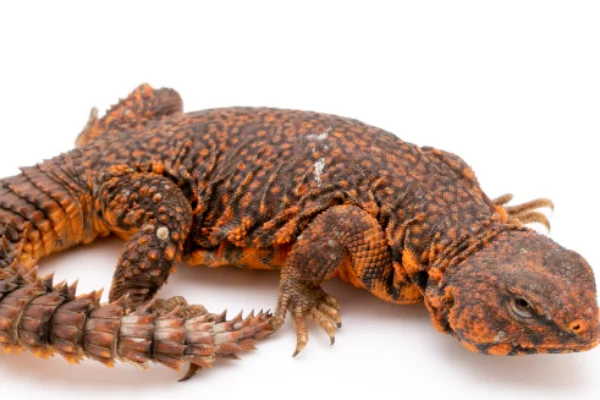
| Scientific Name | Uromastyx geyri |
| Length | around 34 cm |
| Location | Southern Algeria, eastern Mali, and northern-central Niger |
| Diet | dark green leafy vegetables and dried peas, lentils, and seeds |
The Saharan Uromastyx is a medium-sized lizard with a reddish-orange or yellow body and dark brown rough scales all over it. These lizards can grow up to 34 cm and weigh up to 900 grams.
They are very strong lizards and have rings of spines over the tail that can be used as a defense mechanism. They are found in the Sahara Desert.
12. Red-headed Rock Agama

| Scientific Name | Agama agama |
| Length | 20-30 cm |
| Location | sub-Saharan Africa |
| Diet | fruits, vegetables, insects, rodents, birds, and fish |
The Red-headed Rock Agama is a small lizard, typically growing to be 13-30 cm in length. Males are typically larger than females.
They have a long tail, a large head, and external ear openings. The body is brown with a light stripe down the middle and six to seven dark patches on the side. The head is red in dominant males, olive green in females, and in subordinate males.
13. Panther Chameleon

| Scientific Name | Furcifer pardalis |
| Length | 36-53 cm |
| Location | northern and coastal areas of Madagascar |
| Diet | mealworms, super worms, waxworms |
Panther Chameleon is a multi-colored lizard with a bright red face that can grow up to 53 cm. Like other Chameleons, Panther Chameleons can also change the color of their body according to the surrounding environment. These chameleons are solitary animals that only come together to mate.
They are carnivores and love to eat various types of worms like mealworms, super worms, etc. They can be easily found in the coastal areas of Madagascar.
14. Oriental Garden Lizard
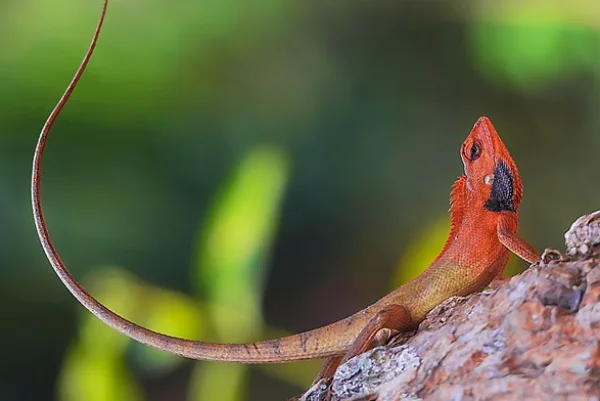
| Scientific Name | Calotes versicolor |
| Length | up to 37 cm |
| Location | SE Iran, Afghanistan, Bangladesh, Bhutan, Cambodia, India, Indonesia, Malaysia, Maldives, Mauritius, Myanmar, Nepal, |
| Diet | crickets, grasshoppers, ants |
Oriental Garden Lizards are commonly found in greenish-brown and orange color with dark markings. But during the breeding season, their heads become bright red making them more vibrant.
Like most lizards, they are also diurnal meaning mostly active during the day. Oriental Garden lizards are very common lizards found in various parts of the world.
15. Broad-headed Skink

| Scientific Name | Plestiodon laticeps |
| Length | 16-32 cm |
| Location | southeastern United States |
| Diet | mainly insects, spiders, and other invertebrates, but will also eat mollusks, rodents, and small reptiles |
Now, we are ending this list with Broad-headed skinks. Unlike Red-tailed skinks, they are wider and longer and have a reddish-orange head.
Broad-headed skinks are native to the southeastern United States. It gets its name from the wide jaws, giving the head a triangular appearance. Adult males are brown or olive-brown in color and have bright orange heads during the mating season in spring.
Here, we conclude our article on “15 Incredible Red Lizards.” We hope you like our post. Indeed, some of the lizards are in partial red color, but during the breeding season, they develop vibrant red hues to show their dominance and attract females. We will be back with another exciting post; till then, stay tuned with us.
Also Read:

Meet Monty, the visionary founder of How It See, being an engineering student, he’s fueled by an insatiable curiosity about the world around him. He is captivated by an eclectic correlation between animal groups, science, and nature, and this fascination drives his quest for understanding.
After completing his degree, he’s set on a mission to delve deep into the realm of nature, accumulating knowledge to share with you through his writing. In the meantime, he loves to watch anime and read anime.
